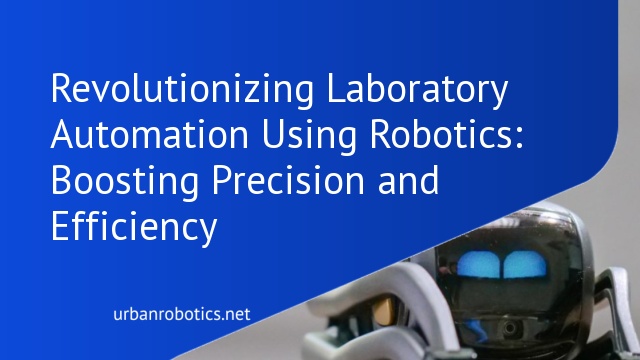Understanding Laboratory Automation
Laboratory automation integrates robotic systems into scientific workflows. These systems handle routine tasks like sample preparation, data collection, and analysis. By using robots, labs achieve higher throughput and consistency.
Automating laboratories reduces human error in repetitive tasks. Robotic systems follow precise protocols, minimizing variations. This accuracy ensures reliable data, crucial for reproducibility in research.
Robotics also enhances efficiency by speeding up processes. For instance, high-throughput screening benefits significantly, allowing scientists to test thousands of samples quickly. Laboratories can then focus resources on more complex tasks.
Automation supports data management. Robots collect and organize data systematically, aiding in comprehensive analysis. This organized approach streamlines data retrieval and reporting.
Using robotics in labs cuts down operational costs. With less need for manual labor, laboratories save on time and expenses. Automation enables labs to operate continuously, increasing productivity.
Laboratory automation via robotics transforms scientific research. The integration of these advanced systems underscores the importance of precision, efficiency, and data reliability in modern laboratories.
The Evolution of Robotics in Laboratories
Robotics in laboratories has come a long way, evolving from simple mechanized arms to sophisticated automated systems. This progression has fundamentally transformed how we conduct scientific research.
Early Innovations
Early laboratory robotics, developed in the 1980s, focused on automating repetitive tasks. Simple liquid handlers and pipetting machines were among the first innovations. These early systems enhanced precision and reduced manual labor but had limited flexibility. Despite these constraints, they laid the groundwork for more advanced automation technologies.
Current Technologies
Current laboratory robotics now include advanced robotic arms, automated storage and retrieval systems, and AI-driven platforms. These technologies enable complex tasks like high-throughput screening, genomic sequencing, and automated microscopy. Enhanced programmability and software integration offer unprecedented flexibility and scalability, making current systems vital in modern labs.
Benefits of Laboratory Automation Using Robotics
Laboratory automation using robotics brings numerous advantages that significantly impact scientific research.
Increased Efficiency
Robotic automation reduces time spent on repetitive manual tasks. Automated systems process multiple samples simultaneously, increasing throughput. Robots operate continuously without breaks, speeding up workflows. As a result, scientists get more time to focus on complex research activities.
Enhanced Precision
Robots minimize human errors in sample handling and data recording. Precision is critical for reproducibility, ensuring consistent results across experiments. Robotic systems perform tasks with high accuracy, reducing variability. This uniformity is vital for reliable research outcomes.
Cost-Effectiveness
Automation reduces labor costs by minimizing manual interventions. It also optimizes reagent usage, cutting down waste. Initial setup costs are offset by long-term savings through increased productivity and fewer errors. These efficiencies translate into significant cost reductions for laboratories.
Key Applications of Robotics in Laboratories
Laboratory robotics offer transformative potential in several critical applications.
Sample Handling and Preparation
Robotics enhance sample handling and preparation by automating repetitive tasks. Robots handle tasks like pipetting, centrifugation, and sample sorting, ensuring precision. This minimizes human errors and contamination risks, allowing consistent results. For instance, robotic arms can prepare numerous samples simultaneously, significantly boosting throughput. These systems also streamline processes by integrating with other lab instruments, fostering seamless workflows.
Automated Analysis and Reporting
Robotic systems automate complex analysis and reporting processes, enhancing data accuracy and consistency. These systems integrate with laboratory information management systems (LIMS) to process and analyze sample data. By performing high-throughput analyses, robotic platforms handle tasks such as spectroscopy, chromatography, and genetic sequencing. Post-analysis, robotic systems generate detailed reports, enabling faster decision-making and reducing manual labor, allowing researchers to focus on interpretative tasks.
Challenges and Considerations
Implementing laboratory automation using robotics presents unique challenges. Addressing these obstacles ensures successful deployment and sustainable operation.
Implementation Costs
Initial costs for laboratory automation can be significant. Robotic systems require sizable investments for hardware, software, and infrastructure upgrades. Maintenance costs, including repairs and parts, also add to the financial burden. Grants or phased implementations help manage expenses. Careful budgeting and funding strategies mitigate the financial impact.
Technical Training
Expertise is critical to operate advanced robotic systems. Staff must undergo technical training to handle robotic tools and interpret data. Training programs, workshops, and certifications ensure staff proficiency. Continuous education keeps personnel updated with technological advancements. Well-trained staff maximizes the efficiency and benefits of automation.
Future Trends in Laboratory Automation
Laboratory automation is continuously evolving, paving the way for innovative solutions that enhance productivity and accuracy. Key trends to watch include AI integration and expansion to diverse research areas.
AI and Machine Learning Integration
AI and machine learning (ML) are revolutionizing laboratory automation. AI algorithms analyze large datasets faster, identifying patterns and anomalies that humans might miss. ML enhances predictive analytics, improving experiment outcomes and facilitating real-time decision-making. Integrating AI with robotic systems optimizes workflows, reduces repetitive tasks, and enhances overall lab efficiency. By incorporating these technologies, laboratories can achieve higher precision and streamlined processes, fostering groundbreaking scientific discoveries.
Expansion to New Research Areas
Robotic automation isn’t limited to traditional laboratory settings. Emerging fields like genomics, proteomics, and personalized medicine are increasingly adopting these technologies. For instance, high-throughput sequencing requires precise sample handling, easily managed by robotic systems. In drug discovery, automation accelerates compound screening and toxicity testing, enhancing drug development pipelines. By expanding to new research areas, robotic automation broadens its impact, driving innovation and advancing scientific knowledge across various disciplines.
Conclusion
Laboratory automation using robotics is revolutionizing the way we conduct scientific research. The precision and efficiency offered by robotic systems not only streamline workflows but also elevate the reliability of our data. As we integrate AI and machine learning into these systems, the potential for faster data analysis and predictive analytics becomes even more promising. While challenges like initial costs and staff training exist, the long-term benefits far outweigh these hurdles. The expansion of robotic automation into fields such as genomics and drug discovery underscores its growing influence on scientific progress. Embracing this technology will undoubtedly lead to groundbreaking advancements in research and development.





